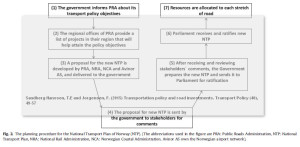 Why is it that some infrastructure projects in sparsely populated regions of Norway receive more funding than other projects in more densely-populated regions where the potential benefit/cost ratio would be much better? That is the question asked by Thor-Erik Sandberg Hanssen and Finn Jørgensen in their recent article on Transportation policy and road investments. The article hits the nail on the head on the topic of how Norways is spending – or perhaps “wasting” money on its infrastructure.
Why is it that some infrastructure projects in sparsely populated regions of Norway receive more funding than other projects in more densely-populated regions where the potential benefit/cost ratio would be much better? That is the question asked by Thor-Erik Sandberg Hanssen and Finn Jørgensen in their recent article on Transportation policy and road investments. The article hits the nail on the head on the topic of how Norways is spending – or perhaps “wasting” money on its infrastructure.
Return of investment
What the authors found was that the reason for spending so much money on some projects was not that the politicians were particularly concerned about the people in these constituencies, but rather that they perceive high political returns for investing in these constituencies. Definitely pork barrel spending in practice. However, it is not so much done intentionally, but as a result of the skewed representation of the electorate in the Norwegian parliament, where less-populated counties with regional road investment projects are overrepresented compared to the more central and well-populated areas and cities.
Deja-vu
This article brought back memories to a blogpost of mine from 2009, Why does the world’s richest country have the world’s worst roads?, where I reflected on a similar paper. Here the conclusion was that the politically attractive projects win over the economically attractive, simply because is not the planning authorities or the central government who decides which national roads to build, but the local politicians, voting for “their” roads in parliament budget discussions. Adding to the misery is that investment or funding decisions are made on a year-to-year basis, thus frequently setting aside any long-term strategies that may exist.
How road investments are done in Norway
The article provides a brief overview of how Norwegian roads are planned and financed.
Which roads that should receive funding are presented in the National Transport Plan(NTP) by the Norwegian Ministry of Transport and Communications. This plan is produced every four years, and covers a period of ten years and aims to provide a base for decision making. The words that need to be stressed here are “aims to be”, because although the plan is ratified by the parliament every four years, it is still only intentional, it is not a binding budget document. Following ratification by parliament, the Norwegian Public Roads Administration then prepares an action plan. However, this action plan still needs yearly funding, and is where local politicians can have great influence.
Politicians know that allocating nationally financed projects to their home districts is an effective way to win votes
Why? Well, every potentisal voter is someone who is out and about driving every day, and everybody enjoys having a good road to drive on, and given the state of much of Norway’s crumbling infrastructure it is not surprising then that good roads win votes easier than other political issues. Voters are just simple-minded, aren’t they?
What factors are the most influential for investment decisions?
To decide whether political representation in the parliament is indeed a driving factor the authors looked at a number of variables and hypothesize that
- roads with longer improvement stretches receive more money, because there are economies of scale to be reaped
- roads with a high average traffic volume receive more money
- roads with a high predicted traffic growth will receive more money
These are variables indicating the present and future importance of the road
- roads with many sharp horizontal curves receive more money (to improve road standard)
- roads that are narrower than 6 metres receive more money (explanation: roads narrower than 6 metres do not have a middle separation line in Norway and are considered sub-standard)
- roads with avalanche problems receive more money
- roads with lower speed limit receive more money, implying that higher speeds reduce travel time and make roads more efficient
These are variables that are linked to the standard of the road
- roads with many fatalities and serious injuries receive more money
- roads with noise nuisance issues receive more money
These are variables that are linked to external costs
- roads in sparsely populated constituencies receive more money
This is the core variable, suggesting that regardless of everything else, this is what matters most. But is that really the case?
Conclusion
Based on their findings the authors conclude that
- the importance of the road matters, but there are neither economies of scale nor diseconomies of scale in Norwegian road investments, suggesting not so much pork barrel spending after all
- the narrowness of the road is the most important factor when it comes to road standard, suggesting that widening narrow is more visible than straightening curves or reducing avalanche problems or increasing speed limits, and hence offer higher political returns, and thus some pork barrel spending
- traffic safety improvements or noise nuisance reductions have no influence on road investments, suggesting that they are simply overlooked by politicians in their final decision making
- parliamentary representation in the electoral district where the road is located influences the amount of money spent significantly, indeed suggesting pork barrel spending
Critique
While this paper is home turf and thus easy to feel at home wit,h I find it hard to see the conclusions from the hypotheses, because the hypotheses are not stated as such explicitly (e.g. H1, H2, H3, etc.), but are stated within the description of the variables (“we assume that…”, “we hypothesize that…”). I would have helped the conclusion if the hypotheses had been stated in listed order, making it easier for the reader to grasp what relationships the authors are actually trying to investigate.
Nonetheless, the authors’ point is still valid: The main critique of the Norwegian procedures for road investments, as highlighted the 2009 paper, is still valid.
Norwegian politicians invest more money in roads in regions overrepresented in the Parliament because the expected political return is higher as fewer voters in these regions to be persuaded for the politicians to win a seat in Parliament.
Well, unless we reform our election system, which I doubt will ever happen, this is a problem we will have to deal with until the end of time. And that is why Norwegian roads always have been, currently are and forever will be, a patchwork of high-standard and sub-standard roads.
Reference
Sandberg Hanssen, T., & Jørgensen, F. (2015). Transportation policy and road investments Transport Policy, 40, 49-57 DOI: 10.1016/j.tranpol.2015.02.010
Author links
- researchgate.net: Finn Jørgensen
- researchgate.net: Thor Erik Hanssen
Related posts
husdal.com: World’s richest country, but he world’s worst roads?













